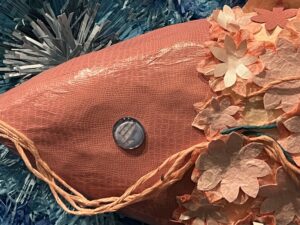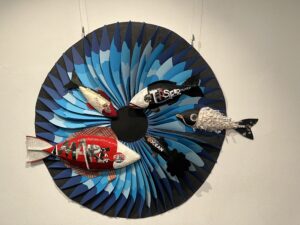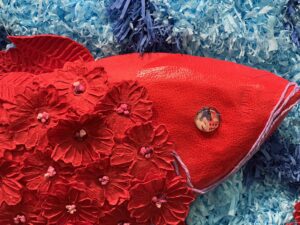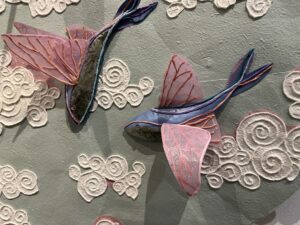Caterina Crepax: of her we admire the tireless curiosity with which she chooses and looks at paper, managing to see its seemingly unthinkable transformations and preciousness. And this time she hypnotizes us by translocating it into an ecosystem far removed from it: into the sea, where it could not exist or live. But instead the very unthinkable happens.
Italian, Milanese, interior architect, master of paper art. Daughter of the well-known cartoonist Guido Crepax, creator of the character “Valentina,” known, translated and published all over the world.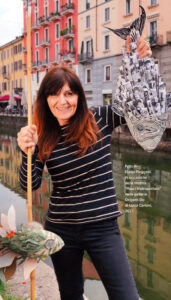
Caterina Crepax has chosen paper as the sole ingredient of her works: paper of all types and origins, with small incursions of wire – where necessary – and vinyl glue. The tools are hands, scissors, dressmaking dummies as bases, styrofoam heads, pins, pencils. And a lot of holy patience, because all his paper sculptures are handmade.
Famous for her stunning tapestries, lamps, sculptures with marvelous plays of light and truly astonishing clothes, she has made the pursuit of wonderment the centerpiece of her interest: “the more the years go by, the more I am convinced that it is one of the reasons why it is worth being in the world. Being able to somehow recreate it in people with my little paper magic is something incredible to me and I feel a duty to share this gift of nature.”
Now he surprises us even more with an exhibition dedicated to fish and the sea in general, toward which we really need to develop new empathies that come through knowledge but also emotions toward its mysterious aquatic creatures. An exhibition entitled “Under the Sign of the Fishes” curated by Irene Ivoi.
Catherine and the Fish World
Perhaps it is no coincidence that Catherine was really born under the sign of Pisces: “and Sagittarius ascendant, which however has the tail of a fish,” the artist points out and continues, “they say about Pisces that they are sensitive, spiritual, often artists, always in the world of dreams and imagination, changeable, chameleon-like, compassionate, calm, shy, resilient. Those born under the sign of Pisces love the tranquility that allows them to reflect and dream; they can’t stand chaos, confusion, so, in general, crowded places. I, as a child, had an incredible imagination and spoke to almost no one. Pisces, being shy, can often be elusive.”
To some, she might remind someone of “Alice in Wonderland” in a fairy tale that is both eternal and real at the same time, as if there were little difference between fantasy and reality: “I used to tell stories in my head and I never stopped doing it. I used to talk to cats and to snails that I would slide on my arms and paint their shells with markers. The voice has always bothered me, because when it comes out of your mouth it is different from how you hear it inside, and often what you say does not correspond exactly to what you would like to communicate.” A silence, that of fish, that makes them sympathetic and empathetic, because fish “savor the wonder of all that blue around them without needing to comment on it.”
The exhibition at the Civic Aquarium of Milan
And it is precisely the Civic Aquarium of Milan, the city institution dedicated to the study and dissemination of issues related to aquatic biodiversity, that is hosting – initially until July 2 but then throughout the summer – the exhibition “Under the Sign of the Pisces,” entirely dedicated to the aquatic world and the creatures that inhabit it.
The exhibition recounts with irony and poetry the artist’s personal inner world, in which, among the colors and chiaroscuro of water, we can admire “metropolitan fish” and other mythological and fantastic aquatic creatures.
A dreamlike and surreal world recreated with paper, a simple, everyday material that Crepax was able to use as a medium to bring his visions and dreams to life. Works made entirely by hand that often give new life to everyday paper materials, forgotten and usually destined to be thrown away.
“An exhibition that takes us on a journey into the depths of water testifying to the beauty and importance of this element and reminding us of the urgency of the protection of aquatic systems,” declares Tommaso Sacchi, councillor for culture of the City of Milan.
An interest that reveals the fascination exerted by that planet water that partly reveals and partly conceals. The beauty, fragility and harmony of a world reproduced using paper are returned to us through a material that is on the surface fragile but in reality very resistant.
When work and passion match
Her work is a passion, or perhaps her passion to give physical form to dreams has become her work. And the source of inspiration is the everything around her, constantly fascinated and intrigued by what she relentlessly observes, like a vision detector: “I find it stimulating to have fences, boundaries to cross. I prefer to have a theme, a reality to interpret imaginatively, more than to work at breakneck speed. If there are no real limits, I create them for myself and try to respect and face them with irony. I put even more effort and passion into it. As it is the latter that pushes me to more and more complex workmanship, to more surprising details, in search of the perfect piece. A constant challenge to myself and my creative and manual skills. When they propose something to me, I never back down, I always say “it can be done.” And my elves back me up, like trusty warriors of a tiny paper army, ready to cut, fold, pleat, unfold, roll, inlay.”
An exciting mystery from the deep
“I was hooked on these sculptures not only because of their admirable workmanship but also because these silent, gentle animals know how to arouse little longings and memories,” writes exhibition curator Irene Ivoi. “But also because they are so full of mystery. Because we know rather little about them. Because they move and disappear at speeds unreachable to us. Because who knows how many times each of us has hoped to touch or take one of them almost as an impossible challenge. Because we almost always do not understand the reason for their moving and swaying. Because they inhabit a system, water, impassable to us except for swimming or playing.”
An exciting mystery that comes from the depths of the sea, where noises become silence, light often does not come and the water becomes dark: “all this contributes to the construction of the emotions that these animals arouse in us when they reveal themselves in their physicality,” Ivoi concludes.
An exhibition that excites and makes us think
This is an important message at a time when we know how much seas, lakes, oceans and rivers with their fauna and flora are threatened by climate change, pollution and the ineffectiveness or absence of policies that can protect them. “The so-called high seas, the area of the ocean that lies beyond countries’ national waters, is the largest habitat on Earth and home to millions of species, but only recently has the United Nations reached out and signed a treaty to protect it,” Irene Ivoi continues.
So the realization is that there is still a long way to go and everyone’s role is not irrelevant, so all actions are significant: “today towards the sea we really need to develop new empathies that come through knowledge but also emotions towards its mysterious aquatic creatures,” she concludes.

